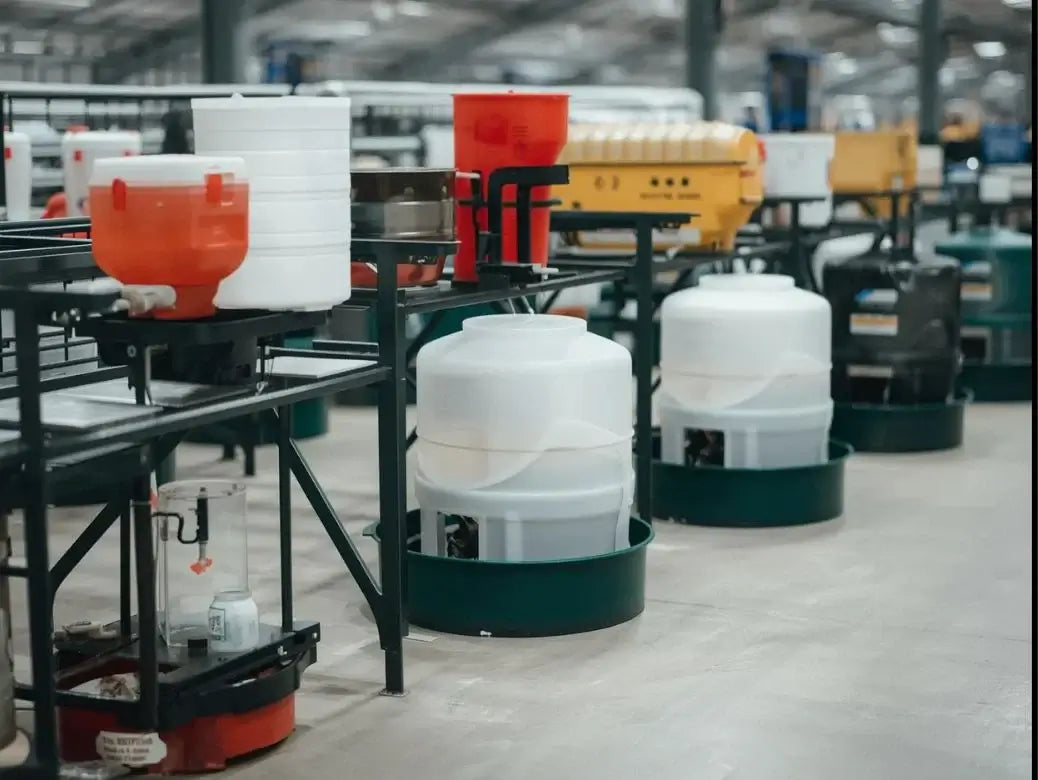
Complete Guide to Poultry Feeders & Drinkers Setup – Types, Features & Best Practices
Share
In poultry farming, feed and water management are the backbone of bird health, growth, and profitability. Whether you’re raising broilers, layers, or breeders, the right feeder and drinker setup ensures your flock gets consistent nutrition, stays healthy, and grows efficiently.
This guide will walk you through the types of feeders and drinkers, their key features, and setup tips to maximize efficiency and minimize waste.
1. Why Feeders & Drinkers Matter in Poultry Farming
Feeding and watering systems are not just containers — they are critical equipment that directly impact:
- Growth rate and feed conversion ratio (FCR)
- Mortality rate and disease prevention
- Labor efficiency and operational costs
- Bird welfare and comfort
A poorly designed or incorrectly set up system can lead to:
- Feed wastage
- Wet litter (leading to diseases like coccidiosis)
- Uneven growth in the flock
-
Increased maintenance costs
2. Types of Poultry Feeders
Choosing the right feeder depends on bird age, flock size, and housing system.
a) Manual Feeders
- Best for: Small flocks or backyard setups
- Design: Simple troughs or hanging feeders
- Pros: Low cost, easy to clean
- Cons: Requires frequent refilling, higher labor
b) Automatic Pan Feeders
- Best for: Commercial broiler and layer farms
- Design: Feed is automatically dispensed from a central hopper via feed lines into circular pans
- Pros: Reduces labor, ensures uniform feed distribution, adjustable height
- Cons: Higher initial investment
c) Linear Feeders
- Best for: Chicks and small birds
- Design: Long troughs with anti‑waste grills
- Pros: Easy access for many birds at once
- Cons: More prone to spillage if not adjusted properly
d) Tube Feeders
- Best for: Medium‑sized flocks
- Design: Vertical tube with feed flowing into a tray at the bottom
- Pros: Gravity‑fed, reduces contamination
- Cons: Needs manual refilling
3. Types of Poultry Drinkers
Water is often called the “forgotten nutrient” — yet birds drink 1.6–2 times more water than feed daily.
a) Chick Fountains
- Best for: Day‑old chicks
- Pros: Easy access, prevents drowning
- Cons: Needs frequent cleaning
b) Bell Drinkers
- Best for: Broilers and layers in deep litter systems
- Design: Suspended bell‑shaped drinker connected to a water line
- Pros: Automatic refill, adjustable height
- Cons: Needs regular flushing to prevent algae
c) Nipple Drinkers
- Best for: Large commercial farms
- Design: Birds peck at a nipple valve to release water
- Pros: Hygienic, minimal spillage, keeps litter dry
- Cons: Requires correct pressure adjustment
d) Cup Drinkers
- Best for: Breeders and layers
- Pros: Birds drink from a small cup, water refills automatically
- Cons: Needs occasional cleaning to prevent buildup
4. Key Features to Look for in Feeders & Drinkers
When selecting equipment, focus on durability, hygiene, and efficiency.
For Feeders:
- Anti‑waste design: Prevents birds from scattering feed
- Adjustable height: Matches bird growth stages
- Easy cleaning: Smooth surfaces, minimal crevices
- Capacity: Matches flock size to reduce refilling frequency
For Drinkers:
- Leak‑proof system: Prevents wet litter
- Flow control: Ensures adequate water without overflow
- UV‑resistant material: Prevents algae growth in outdoor setups
- Easy disassembly: For thorough cleaning
5. Setting Up Your Poultry Feeding & Drinking System
A good setup is about placement, height, and maintenance.
a) Placement
- Keep feeders and drinkers evenly spaced to avoid crowding
- Place drinkers near feeders but not directly above litter to avoid contamination
- Ensure easy access for all birds
b) Height Adjustment
- Feeders: Lip should be at bird’s back height
- Drinkers: Nipple drinkers should be at eye level; bell drinkers adjusted so birds slightly stretch to drink
c) Maintenance
- Clean daily to prevent mold, bacteria, and algae
- Flush water lines weekly
- Check for leaks and blockages
6. Automatic Feeding & Drinking Systems
Modern poultry farms are shifting to automatic lines for efficiency:
-
Benefits:
- Consistent feed and water supply
- Reduced labor costs
- Better hygiene and flock health
-
Examples:
- TWIST Automatic Feeder – Easy cleaning without disassembly, adjustable tilt for bird height
- Automatic Nipple Lines – Centralized water supply with pressure regulators
7. Common Problems & Solutions
| Problem | Cause | Solution |
|---|---|---|
| Wet litter | Leaky drinkers, over‑flow | Adjust pressure, repair leaks |
| Uneven growth | Poor feed distribution | Add more feeders, check feed flow |
| Contaminated water | Dirty lines, algae | Flush lines, use UV‑resistant pipes |
| Feed wastage | Low lip height, no anti‑waste grill | Adjust height, install grills |
8. Cost vs. Benefit
While automatic systems have a higher upfront cost, they:
- Reduce feed wastage by up to 15%
- Save 2–3 hours of labor daily in large flocks
-
Improve bird health, leading to better FCR and profitability
9. Final Tips for Success
- Always match equipment to bird age and type
- Keep a maintenance schedule
- Train staff on correct operation
- Monitor flock behavior — if birds are crowding or avoiding equipment, adjust setup
Conclusion
A well‑planned poultry feeder and drinker setup is an investment that pays off in healthier birds, reduced costs, and higher productivity. Whether you choose manual or automatic systems, focus on hygiene, accessibility, and efficiency.














